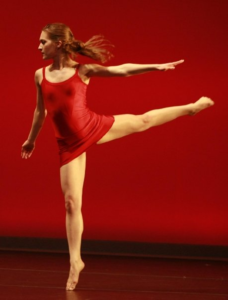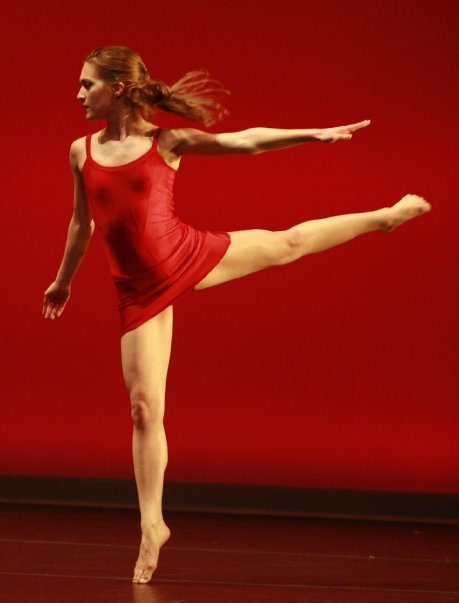In hoopdance we don’t often think of creating lines. Hooping is round and we tend to relate to it with a round mindset. There are many ways we can utilize lines in hoopdance though. We can travel in lines, we can create lines with our posture, our arms, our legs, we can even imagine lines and travel along them with the hand while holding a hoop stationary to create iso-pops (or the pop out in a circular isolation). We must create straight lines to pull off a full across-the chest roll or across-the-back roll. So knowing about lines can help significantly with our hoopdance.
In dance, when referring to “a dancer’s lines” we are referring to the way their limbs, including the body itself, extend through space during their dance. Elongating lines can create a much more impressive visual effect. For example, there is a an enormous difference when a hoopdancer does a lift from the waist and extends the arm fully above the head so that the arm is completely straight as opposed to having a bend in the elbow so that the hoop barely clears the top of the head. This extra extension makes all the difference between a pretty lift and a beautiful lift. It makes the hooper look taller, thinner and more striking.
Another line that is often ignored during lifts is the line made by the arm not doing the lift! Too often, this arm is left to hang like a little broken chicken wing — bent, elbow sticking out, the dancer’s attention entirely on the lifting arm. Viewers, though, notice that elbow. It sticks out like, well, like a bent elbow. Visually, it creates a bump in the line from the fingertips holding the hoop to the feet on the ground. Simply learning to drop the other arm straight down and allow the fingertips to brush gently against the leg makes for a much prettier lift. It creates the illusion that the dancer is taller, the lift higher and the line cleaner. Or, the dancer can tuck the unused arm behind the back and remove it from the equation entirely. In short (pardon the pun), the chicken wing shortens the line and a long arm elongates the line.
Elongating the body requires conscious effort. I recommend practicing in front of a mirror. From the floor build your posture tall and then experiment with the various ways you can create lines with your arms and legs, together and separate from one another.
The first line all dancers must consider is their posture. Lengthen the spine!!! Keep the chin level, shoulders back and down, posture upright and not leaning forward. Good posture requires lifting from the heart, which removes the weight of the upper body from the lower body and frees the arms to move freely and utilize their full range of motion. For the lower body, the knees are slightly bent, the gluts tightened, the lower abs tightened and the pelvis is pulled into a slight pelvic tilt. This frees the legs to move freely and explore their range of motion as well.
Recognizing which moves are most likely to shorten your lines is the first step toward eliminating them from your dance. Some of the things that can shorten your lines include dropping the chin, looking down at the floor, having the shoulders rolled forward, having the elbows bent, non-directed gaze (meaning, staring off into space. Even directed gaze can be used to create the illusion of elongating the limbs. Focusing the gaze beyond the dancer’s fingertips goes a long way to creating the illusion of longer lines), slouching, having a bent hand at the end of a long arm or a flexed foot at the end of a long leg, But, again, perhaps the biggest bedeviler of a beautiful line in hooping is that bent elbow! So just add these things to your consciousness and begin to notice them in your dance.
The next step to elongating your lines is consciously playing with them. Create as many straight lines as you can with your arms and with your legs. Create parallel arms with both arms or both legs or one arm and one leg. Create perpendicular line where one arm is up while the other is out or forward. Create lines where the elbow is bent so that is is flush with the upper arm, tucking the thumb in the arm pit so that the upper arm itself becomes a short line. There are infinite variations of lines.
This is a link to my very first hooping video. It has a lot of examples of lines and I’ve tried to detail some of them below by way of example:
– Parallel arms 0:24 (that follow through to an isolation roll)
– Single long arm extended with directed gaze beyond the fingertips 0:36-0:40
– Parallel arms behind while in sustained spin 1:40
– Very high lift (accompanied by perpendicular straight arm line also) 1:55
– Open arms while holding hoop extended 2:45-2:50
– Push outs with hold (two parallel arms) 2:58-3:00
– One leg straight 3:02
– Parallel arm AND leg (I love this one) 3:04 (notice the toe is pointed too)
And the move that didn’t work at 3:52 would have temporarily created four lines in four different directions!!!
You can also create lines simply in how you use your arms, creating one line with both arms (either straight across, straight up and down or straight forward and backward), creating two parallel lines, creating two perpendicular lines. You can do lines in any direction. Think cheerleading. Think Bob Fosse. Think Indian Classical Dance and Bollywood.
Another way to lengthen lines is to lengthen traveling steps. Once you have learned a turn or a traveling step, learning to make those steps large will make you appear more confident and proud as well as taller and longer. The larger the steps, the longer the lines.
You can also add inches by extending through the fingertips and through the toes. A lifted leg that ends in a flexed foot appears to stop that line short. A flexed foot may be utilized. A bent arm may be utilized. It’s just important to utilize these things consciously, because you choose to, rather than unconsciously where they can detract from your dance. And, more importantly, you can consciously and creatively add to your dance by deliberately utilizing lines. Have at it! And enjoy.




Pingback: Top Hat Hoopdance Award Winners 2015! | Caroleeena's Circles of Joy